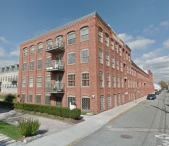Mill Record Stonington
RETURN TO ‘FIND MILLS’Disclaimer: Content for these properties was compiled in 2014-2017 from a variety of sources and is subject to change. Updates are occasionally made under Property Information, however the Connecticut Trust for Historic Preservation (dba Preservation Connecticut) makes no representation or warranty that the information is complete or up-to-date.
- Complex Name (Common)
- Atwood Machine Co.
- Complex Name (Historic)
-
- Trumbull Iron Works
- Address or Location
- 8 Stonington Commons, Stonington
- County
- New London
- Historic Designation
- Associated Mill Community
- n/a

- Historic Information
Companies Associated w/Complex
- Atwood Machine Co. 1876
- Jocelyn Fire Arms c.1860
- Standard Braid Co. c.1865
- Trumbull Iron Works c.1851
Use (Historic)
Largest Documented Workforce
n/a
Historic Narrative
J. F. Trumbull built the first structures in this complex in 1849-51. Trumbull Iron Works employed 10 men in 1860 and produced 150 cotton gins and 6 steam engines. Trumbull was gone by the late 1860s and a braiding firm occupied the plant. In 1876 Atwood Machine Co. bought the buildings. This company originated in Mansfield, CT and grew from the silk manufacturing sector in that town. John E. Atwood founded the firm in 1852 to produce silk-making equipment. In the 1860s his son Eugene's patented inventions in mechanized reeling and spinning of silk propelled the firm's sales beyond local markets. Atwood Machine moved to Willimantic in 1870 and to this plant six years later. The company's growth accelerated in the 1880s, again because of product improvements by Eugene Atwood, notably his self-centering spindle which allowed substantially faster thread-making. Several manufacturers have occupied the plant since Atwood Machine went out of business after World War II. (Roth)
- Architectural Information
Number of Existing Buildings
n/a
Dates of Construction
1849-51, c.1876, 1896, c.1915
Architect
n/a
Builder
n/a
Building Type
Architectural Description
J. F. Trumbull built the first structures in this complex in 1849-51. The main buildings, a 3 1/2-story machine shop and high 1-story foundry, both have walls of random-coursed stone. The 108' x 74' machine shop has a gable roof; the foundry was originally 62' long and about 30' wide, but was altered by a later occupant. Atwood Machine widened the foundry to 41' and rebuilt the roof to include a low, narrow monitor, thus giving the structure the typical foundry form of the late 19th century. In 1896 a 2-story brick pier mill, 67' x 65' with near-flat roof, was erected along Water St. The rest of the plant went up during World War I; brick-pier extensions covered the entire Water St. side of the property and a new foundry, 128' x 87', was added. (Roth) Leo F. Caproni may have designed an addition for the complex prior to 1938 (Leo F. Caproni Architect & Engineer" 1938 booklet).
Exterior Material(s)
Structural System(s)
n/a
Roof Form
Roof Material
n/a
Power Source
n/a
Condition
Excellent
Condition Notes
A fire in 2003 demolished the buildings; the stone mill and foundry from the Trumbull Ironworks were rebuilt, as were brick loft shells.
- Property Information
-
Specific Location
West side of Water Street across from Diving Street
Located in Stonington Borough National Historic District (1979).
http://npgallery.nps.gov/nrhp/GetAsset?assetID=fce98cc8-d081-4b4f-99e9-12e1a18604b9Adjacent To
n/a
Exterior Visible from Public Road?
Yes
Parcel ID / Assessor Record Link
- 101-1-1-1 (sample) / Link →
Acreage
n/a
Use (Present)
- Sources
-
Form Completed By
n/a
Date
n/a
Bibliography
- Roth, Matthew, et al, Connecticut: An Inventory of Historic Engineering and Industrial Sites (Washington DC: SIA, 1981).
- Information, historic photographs and sources for Leo Caproni courtesy Gregg Bateman (2018).
- Representative View(s)Click on image to view full file





